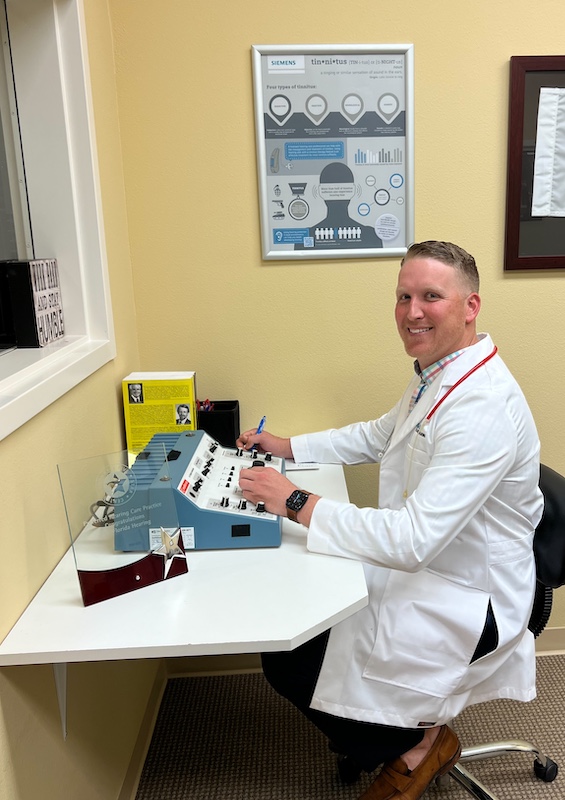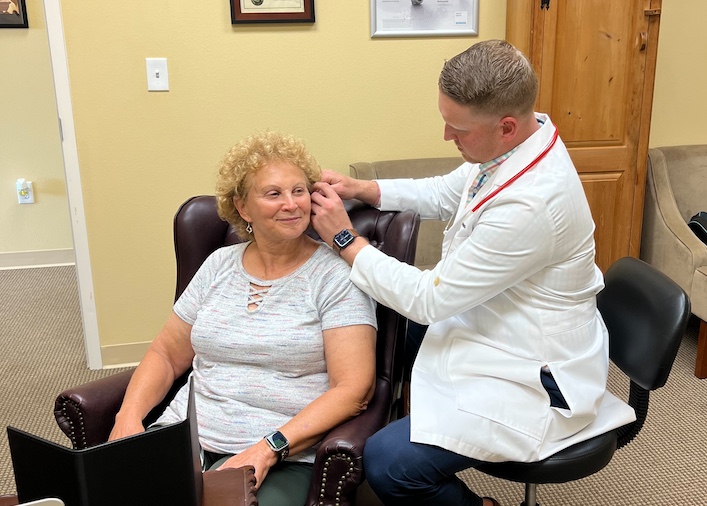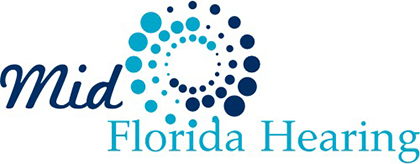What to Expect at a Hearing Test
During the consultation, we will ask you about your hearing history and your family history, as well as any other noise-related events that may have affected your hearing in a single incident. With this background information in place, we move on to your hearing test.
First, in the physical examination, we check your ears and ear canals using an otoscope. We look for any injuries or irregularities in your ears that might obstruct your hearing.
The pure tone test is used to evaluate your ability to hear sounds with different features, namely volume (or amplitude) and pitch (or frequency). To test your hearing capacity, we play different sounds for you and ask you to respond by pressing a button indicating that you have heard the sound.
Many hearing healthcare providers will begin with sounds at a louder level, though they should not be uncomfortable to you, and they will become increasingly softer. Other evaluators find it beneficial to provide a mixed bag of frequencies and amplitudes to test which you can hear. The most important thing to keep in mind with a Pure Tone Audiometry evaluation is that nobody can hear all the tones played. Every pair of ears will lose the ability to hear at some point. Don’t be embarrassed if you are unable to hear a sound. That is precisely the reason for the test. Simply relax your mind and focus your attention on the sounds coming to you.
Another test we will perform is Speech Audiometry. This type of test not only involves playing sounds of varied amplitude and frequency, but also speech is introduced to the test. Sometimes you may hear full words, but other times these will be the smaller building blocks of language, such as syllables or phonemes. The benefit of this kind of test is being able to analyze if there are sounds, combinations of sounds, or types of voices that are difficult to hear. Some people have trouble understanding what people say at a quiet level, even though they might be able to hear pure tones in that range. Other people have particular trouble hearing children’s voices. By adding speech to the pure tone test, we are better able to assess your level of hearing in a crucial context: conversation.
- Masked Air and Bone Conduction: Audiometric masking is used to provide the most accurate results from a Pure Tone Audiometry evaluation. It involves playing a masking noise to one ear through headphones. This separates the ears by preventing the non-test ear to assist the ear that is being evaluated. Another type of hearing test is bone conduction which helps determine the type of hearing loss someone is experiencing. It is performed by placing a headband on the patient that has a small device that sits behind the ear, called an oscillator. The oscillator vibrates and sends these tones directly to the cochlea, meaning that the outer and middle ears are skipped. This identifies if the hearing loss is occurring in the outer, middle, or inner ear.
- MCL and UCL: Pure Tone Audiometry is the most common type of diagnostic evaluation used to assess hearing loss. This test involves wearing headphones - in a soundproof room - that are attached to an audiometer that plays sounds as different frequencies. You will indicate the sounds you are able to hear and these results will be captured in real-time. They will be presented to you on an audiogram which is a chart that graphically shows the specifics of your hearing loss. This includes Most Comfortable Loudness (MCL) and Uncomfortable Loudness Level (UCL). MCL represents the loudest level at which sound is comfortable to hear. UCL represents the level at which sound is uncomfortable for the listener. These data points help identify the individuals hearing thresholds which inform what their hearing needs are.
- Masked Air and Bone Conduction: Audiometric masking is used to provide the most accurate results from a Pure Tone Audiometry evaluation. It involves playing a masking noise to one ear through headphones. This separates the ears by preventing the non-test ear to assist the ear that is being evaluated. Another type of hearing test is bone conduction which helps determine the type of hearing loss someone is experiencing. It is performed by placing a headband on the patient that has a small device that sits behind the ear, called an oscillator. The oscillator vibrates and sends these tones directly to the cochlea, meaning that the outer and middle ears are skipped. This identifies if the hearing loss is occurring in the outer, middle, or inner ear.
- MCL and UCL: Pure Tone Audiometry is the most common type of diagnostic evaluation used to assess hearing loss. This test involves wearing headphones - in a soundproof room - that are attached to an audiometer that plays sounds as different frequencies. You will indicate the sounds you are able to hear and these results will be captured in real-time. They will be presented to you on an audiogram which is a chart that graphically shows the specifics of your hearing loss. This includes Most Comfortable Loudness (MCL) and Uncomfortable Loudness Level (UCL). MCL represents the loudest level at which sound is comfortable to hear. UCL represents the level at which sound is uncomfortable for the listener. These data points help identify the individuals hearing thresholds which inform what their hearing needs are.

Reviewing Your Results
The audiogram charts your hearing abilities by ear. If a hearing loss is detected, the audiogram will map out the degree & configuration. Don’t worry if you can’t understand the details of the audiogram. Our team at Mid Florida Hearing is there to interpret the results for you, thoroughly discussing the specifics of your hearing loss. This will then be used to devise a treatment plan tailored to your particular results.
Our team is dedicated to helping you choose hearing aids that are cost-efficient and also effective for your everyday lifestyle. Call us today for your FREE hearing exam and take your next step to enhance your everyday lifestyle!

EXCELLENTTrustindex verifies that the original source of the review is Google. I am so happy with my Phonak Lumity hearing aids that I purchased this year at Mid-Florida Hearing. Bart, Zack and Ashley have all been very helpful and wonderful to work with!Trustindex verifies that the original source of the review is Google. I was treated with care, respect, and understanding in ordering the suggested best hearing aids for my situation. Mid Florida Hearing is a trusted and experienced business that doesn't move away on us... And I purchased all future adjustments to my Ponak Lumity product. Super business and operators! Owners that are experts at hearing lose. Checkups were very helpful thanks to all the friendly employeesTrustindex verifies that the original source of the review is Google. They are spot on, professional, understanding and caring. My wife and I both highly recommend them.Trustindex verifies that the original source of the review is Google. Great service & excellent hearing aids!!Trustindex verifies that the original source of the review is Google. Zach and Ashley are the best in customer service that you will ever find! Service after the sale describes this business to a tee. They are always friendly, happy to see you, and ready to solve any problem you may be experiencing with your hearing aides. This business is way above the rest.Trustindex verifies that the original source of the review is Google. Zach and Ashley helped me with my hearing test and purchasing new hearing aids and I cannot praise them enough. They went above and beyond for me, made themselves available to accommodate my heavy work schedule to fit me in for adjustments and provided the best customer experience I’ve had to date. My father has the same congenital hearing loss and purchased his new hearing aids in alabama and he did not get half the assistance and follow up care that I have received.. and my top of the line hearing aids were almost 2k cheaper then what he paid. Highly recommend this company!!Trustindex verifies that the original source of the review is Google. They have always taken very good care of me and now my mother. I’m on my third pair now. Highly recommend ! Thank you.Trustindex verifies that the original source of the review is Google. Excellent customer service (always with a smile) ... just walk in and they will help you.Trustindex verifies that the original source of the review is Google. I looked at 4 different hearing aid companies, and am so glad I went with Mid Florida Hearing. Saved money and excellent service. A great combination.Trustindex verifies that the original source of the review is Google. Zack did a awesome job. Great place!! Very happy !!
